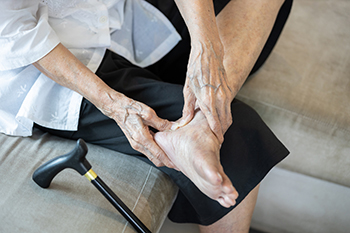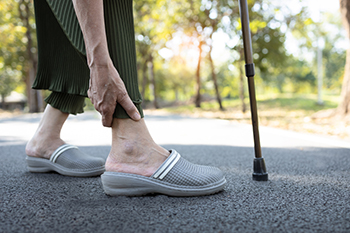Blog
Effective Foot Care Techniques for Diabetic Patients

One of the most important things diabetic patients can do is to take proper care of their feet. Diabetes is a condition that is a result of elevated blood sugar levels, and this can damage the nerves in the feet. This may cause the inability to feel existing sores, bruises, and scrapes that have developed. These can become infected if prompt treatment is not received. Diabetic foot care can begin with washing the feet using warm water, and drying them thoroughly, especially between the toes. This is followed by checking the soles of the feet for any cuts, which can be done by using a mirror. If family members or caregivers are available, they may be able to help with this task. It is beneficial that the toenails be trimmed on a regular basis, and many people will have their podiatrist do this. Engaging in a gentle stretching and exercise routine can stimulate blood flow to the feet, and it is helpful to incorporate healthy eating habits into the daily regime. If you have diabetes, it is strongly suggested that you are under the care of a podiatrist who can help you to manage this condition.
Diabetic foot care is important in preventing foot ailments such as ulcers. If you are suffering from diabetes or have any other concerns about your feet, contact Jack A. Sasiene, DPM from Texas. Our doctor can provide the care you need to keep you pain-free and on your feet.
Diabetic Foot Care
Diabetes affects millions of people every year. The condition can damage blood vessels in many parts of the body, especially the feet. Because of this, taking care of your feet is essential if you have diabetes, and having a podiatrist help monitor your foot health is highly recommended.
The Importance of Caring for Your Feet
- Routinely inspect your feet for bruises or sores.
- Wear socks that fit your feet comfortably.
- Wear comfortable shoes that provide adequate support.
Patients with diabetes should have their doctor monitor their blood levels, as blood sugar levels play such a huge role in diabetic care. Monitoring these levels on a regular basis is highly advised.
It is always best to inform your healthcare professional of any concerns you may have regarding your feet, especially for diabetic patients. Early treatment and routine foot examinations are keys to maintaining proper health, especially because severe complications can arise if proper treatment is not applied.
If you have any questions please feel free to contact our offices located in Texas City and Lake Jackson, TX . We offer the newest diagnostic and treatment technologies for all your foot and ankle needs.
Is Podiatry Right for Me?

People who have foot or ankle pain are typically treated by a podiatrist. These are doctors that specialize in ailments that occur in these parts of the body, and many podiatrists can perform surgery. There are several years of mandatory education required to become a Doctor of Podiatric Medicine, or DPM. This begins with obtaining a bachelor's degree, followed by enrolling in podiatry school. Oftentimes podiatrists obtain a Bachelor of Science degree. Medical school will focus on the feet and ankles, and it is helpful to pursue volunteer work and internships. This is a four-year program, and education continues with a residency program, totaling seven years after obtaining a BS. A residency involves working in a hospital or clinic setting, which must be completed before working independently. If you are interested in pursuing podiatry as a career, please plan to spend some time conferring with this type of doctor who can answer any questions you may have.
If you are experiencing pain in the feet or ankles, don’t join the stubborn majority refusing treatment. Feel free to contact Jack A. Sasiene, DPM from Texas. Our doctor can provide the care you need to keep you pain-free and on your feet.
What Is a Podiatrist?
Someone would seek the care of a podiatrist if they have suffered a foot injury or have common foot ailments such as heal spurs, bunions, arch problems, deformities, ingrown toenails, corns, foot and ankle problems, etc.
Podiatric Treatment
A podiatrist will treat the problematic areas of the feet, ankle or lower leg by prescribing the following:
- Physical therapy
- Drugs
- Orthotic inserts or soles
- Surgery on lower extremity fractures
A common podiatric procedure a podiatrist will use is a scanner or force plate which will allow the podiatrist to know the designs of orthotics. Patients are then told to follow a series of tasks to complete the treatment. The computer will scan the foot a see which areas show weight distribution and pressure points. The podiatrist will read the analysis and then determine which treatment plans are available.
If you have any questions please feel free to contact our offices located in Texas City and Lake Jackson, TX . We offer the newest diagnostic and treatment technologies for all your foot and ankle needs.
Three Grades of Ankle Sprains

Having a sprained ankle can cause difficulty in completing daily activities. It happens when the ankle is suddenly twisted from falling, or from unexpectedly stepping off of a curb. Patients who have had a previous ankle injury may be prone to incurring another one, and wearing shoes that lack adequate support may lead to getting a sprained ankle. This type of injury can be classified into three categories that are referred to as grades. Swelling, soreness, and bruising can indicate a Grade 1 sprain, and recovery time can take up to four weeks. A Grade 2 sprain happens when a ligament in the ankle becomes partially torn, and it is often difficult to walk. A boot may be worn to stabilize the ankle as it heals, which can take up to eight weeks. A Grade 3 sprain is the most serious type of sprain, and happens when the ligament is completely torn. Surgery may be necessary if healing does not gradually occur. If you have sprained your ankle, it is suggested that you consult with a podiatrist as quickly as possible who can properly diagnose and treat ankle sprains.
Ankle sprains are common but need immediate attention. If you need your feet checked, contact Jack A. Sasiene, DPM from Texas. Our doctor can provide the care you need to keep you pain-free and on your feet.
How Does an Ankle Sprain Occur?
Ankle sprains take place when the ligaments in your ankle are torn or stretched beyond their limits. There are multiple ways that the ankle can become injured, including twisting or rolling over onto your ankle, putting undue stress on it, or causing trauma to the ankle itself.
What Are the Symptoms?
- Mild to moderate bruising
- Limited mobility
- Swelling
- Discoloration of the skin (depending on severity)
Preventing a Sprain
- Wearing appropriate shoes for the occasion
- Stretching before exercises and sports
- Knowing your limits
Treatment of a Sprain
Treatment of a sprain depends on the severity. Many times, people are told to rest and remain off their feet completely, while others are given an air cast. If the sprain is very severe, surgery may be required.
If you have suffered an ankle sprain previously, you may want to consider additional support such as a brace and regular exercises to strengthen the ankle.
If you have any questions please feel free to contact our offices located in Texas City and Lake Jackson, TX . We offer the newest diagnostic and treatment technologies for all your foot and ankle needs.
Reminder: When Was the Last Time...?
Many Seniors Live With Chronic Foot Pain

As people age, the prevalence of foot pain increases. Despite this fact, geriatrics studies show that with routine foot care, proper footwear, and use of orthotic devices foot pain can often be reduced. When the foot is in pain, normal biomechanics of standing and walking can be affected. This can lead to instability, an increased risk of falls, a reduced ability to walk, and a loss of independence in seniors. A more sedentary lifestyle can develop, further weakening the strength and mobility of the feet and ankles. Women have more reported foot deformities, which cause pain, than men, believed to be associated with the long-term wearing of high heels. Another major factor in foot pain in the elderly is obesity. Other common conditions that result in foot pain include underlying conditions, such as diabetes and arthritis. Further conditions noted to be common foot ailments of seniors are corns and calluses, fungal toenail infections, bunions, and hammertoes. Foot pain in seniors severely affects their ability to walk at a normal pace and increasingly reduces their willingness to leave the house. For seniors who are becoming hobbled by foot pain, it is strongly suggested that regular appointments with a podiatrist can help to manage and even overcome many of their problems.
If you need your feet checked, contact Jack A. Sasiene, DPM of Texas. Our doctor will attend to all of your foot and ankle needs and provide you with quality treatment.
Geriatrics and Podiatry
When people age, some common issues that may occur are bone density loss, dry skin, poor circulation, and rough brittle nails. These issues may also affect your foot health if the necessary steps are not taken to alleviate the problems.
It is important to take care of your feet because feet that are injured or diseased can affect your overall health. Having painful feet hinders your ability to do daily activities or may decrease your willingness to do the things that you need to do.
Visiting Your Geriatrician
As we age, health problems become more likely, so it is essential to visit your doctor for check-ups to ensure that you are doing the best you can to take care of your health. It is recommended to check your feet frequently for any possible cuts, bruises, swelling, corns or any other irregularities.
Taking Care of Elderly Feet
Cracked or dry feet can be treated by applying moisturizer often. It is also important not to wear old socks because the older the sock is, the higher the possibility there will be that there is bacteria there. Wear fresh socks and make sure they fit properly.
Proper foot health means that you can have a more active lifestyle and you will not be bogged down by pain. Foot health also leads to good circulation, which is paramount for overall health.
If you have any questions, please feel free to contact our offices located in Texas City and Lake Jackson, TX . We offer the newest diagnostic tools and technology to treat your foot and ankle needs.
Slowly Increasing Activity Is Beneficial for Seniors

The importance of maintaining proper foot care increases as the aging process occurs. This may be a result of walking or standing at various jobs throughout the years, in addition to possibly wearing shoes that do not fit correctly. Many elderly people have difficulty looking at the soles of their feet. This is imperative to do, as it is helpful in checking for existing cuts, scrapes, and bruises. There are patients who choose to have a family member or caregiver that can help them to accomplish this. When the toenails are properly trimmed weekly, it may help to prevent painful foot conditions, such as ingrown toenails, from developing. The feet can be protected by refraining from walking barefoot, and slowly increasing physical activity which is beneficial in improving blood circulation to the feet and legs. If you are interested in learning more about how to care for elderly feet, it is advised that you consult a podiatrist who can provide you with the knowledge you are seeking.
Proper foot care is something many older adults forget to consider. If you have any concerns about your feet and ankles, contact Jack A. Sasiene, DPM from Texas. Our doctor can provide the care you need to keep you pain-free and on your feet.
The Elderly and Their Feet
As we age we start to notice many changes in our body, but the elder population may not notice them right away. Medical conditions may prevent the elderly to take notice of their foot health right away. Poor vision is a lead contributor to not taking action for the elderly.
Common Conditions
- Neuropathy – can reduce feeling in the feet and can hide many life-threatening medical conditions.
- Reduced flexibility – prevents the ability of proper toenail trimming, and foot cleaning. If left untreated, it may lead to further medical issues.
- Foot sores – amongst the older population can be serious before they are discovered. Some of the problematic conditions they may face are:
- Gouging toenails affecting nearby toe
- Shoes that don’t fit properly
- Pressure sores
- Loss of circulation in legs & feet
- Edema & swelling of feet and ankles
Susceptible Infections
Diabetes and poor circulation can cause general loss of sensitivity over the years, turning a simple cut into a serious issue.
If you have any questions please feel free to contact our offices located in Texas City and Lake Jackson, TX . We offer the newest diagnostic and treatment technologies for all your foot and ankle needs.
Skin Infection May Cause Athlete’s Foot

A fungal skin infection is the cause of the foot condition that is known as athlete’s foot. It is contagious, and the virus that causes this lives and thrives in warm and moist environments. This often includes shower room floors, public swimming pools, and locker rooms. It is suggested to wear appropriate shoes while in these areas, such as water shoes or flip flops. The symptoms of athletes’ foot can be bothersome, and many people will look for relief. Common symptoms can include severe itching between the toes and on the bottom of the feet, and the skin is often red. In severe cases, blisters will form on different areas of the foot, and prompt medical attention is often sought. If you have developed this condition, it is strongly urged that you are under the care of a podiatrist who can offer you proper treatment methods, which may include prescription cream.
Athlete’s foot is an inconvenient condition that can be easily reduced with the proper treatment. If you have any concerns about your feet and ankles, contact Jack A. Sasiene, DPM from Texas. Our doctor will treat your foot and ankle needs.
Athlete’s Foot: The Sole Story
Athlete's foot, also known as tinea pedis, can be an extremely contagious foot infection. It is commonly contracted in public changing areas and bathrooms, dormitory style living quarters, around locker rooms and public swimming pools, or anywhere your feet often come into contact with other people.
Solutions to Combat Athlete’s Foot
- Hydrate your feet by using lotion
- Exfoliate
- Buff off nails
- Use of anti-fungal products
- Examine your feet and visit your doctor if any suspicious blisters or cuts develop
Athlete’s foot can cause many irritating symptoms such as dry and flaking skin, itching, and redness. Some more severe symptoms can include bleeding and cracked skin, intense itching and burning, and even pain when walking. In the worst cases, Athlete’s foot can cause blistering as well. Speak to your podiatrist for a better understanding of the different causes of Athlete’s foot, as well as help in determining which treatment options are best for you.
If you have any questions please feel free to contact our offices located in Texas City and Lake Jackson, TX . We offer the newest diagnostic and treatment technologies for all your foot and ankle needs.
Keeping on Your Toes

Toes are made up of two or three small, fragile bones. A toe bone can break or fracture when it is stubbed, or if something heavy is dropped on it. Broken toes are common, and treatment is often successful by staying off of the affected foot and elevating it. Additionally, using the buddy taping method, or taping the broken toe to the toe next to it, can help to provide stability that is needed. If one has a severe toe fracture, the big toe may be involved, and a break may cause the toe to become crooked. Tiny fragments of bone can break off, and may result in an open wound. Injuries to the big toe may need a cast or splint for proper healing, and more severe fractures may require surgery. When an individual breaks a toe, they often feel pain, and the toe may become bruised, swollen, and stiff. If you think you have broken your toe and home care methods are not helping, please consult with a podiatrist who can perform a proper diagnosis and provide treatment options that are right for you.
Broken toes may cause a lot of pain and should be treated as soon as possible. If you have any concerns about your feet, contact Jack A. Sasiene, DPM from Texas. Our doctor will treat your foot and ankle needs.
What Is a Broken Toe?
A broken toe occurs when one or more of the toe bones of the foot are broken after an injury. Injuries such as stubbing your toe or dropping a heavy object on it may cause a toe fracture.
Symptoms of a Broken Toe
- Swelling
- Pain (with/without wearing shoes)
- Stiffness
- Nail Injury
Although the injured toe should be monitored daily, it is especially important to have a podiatrist look at your toe if you have severe symptoms. Some of these symptoms include worsening or new pain that is not relieved with medication, sores, redness, or open wounds near the toe.
If you have any questions, please feel free to contact our offices located in Texas City and Lake Jackson, TX . We offer the newest diagnostic and treatment technologies for all your foot care needs.
Do You Suffer From Painful Feet?
Your Feet Should Swell Together

When feet become swollen, it most likely will affect both of them. One swollen foot may be cause for alarm, and it is advised that prompt medical attention is obtained from a podiatrist. One swollen foot may indicate an allergy or infection, possibly causing serious complications if not treated. When both feet are swollen, it is a common condition and can happen for various reasons. These can include water retention from circulatory issues, pregnancy, or premenstrual disorders. Swollen feet may be improved by following a gentle exercise regime and drinking plenty of water. Additionally, having regular massages and reducing sodium intake may help to alleviate swollen ankles. If you suffer from this condition, it is advised that you consult with a podiatrist who can determine what the cause is and offer correct treatment options.
Swollen feet can be a sign of an underlying condition. If you have any concerns, contact Jack A. Sasiene, DPM of Texas. Our doctor can provide the care you need to keep you pain-free and on your feet.
Swollen feet are a common ailment among pregnant women and people who stand or sit for extended periods. Aging may increase the possibility of swollen feet and patients who are obese often notice when their feet are swelling too. There may be medical reasons why swollen feet occur:
- Phlebitis - A condition that causes the veins to become inflamed and can also cause leg pain.
- Liver disease - This may lead to low blood levels of albumin which is a protein. This can cause fluid in the blood to pass into the tissues and several areas of the body can become swollen.
- Heart failure - When the heart doesn’t pump properly the blood that is normally pumped back to the heart can pool in the veins of the legs causing swollen feet.
- Kidney disease - One of the main functions of the kidneys is releasing excess fluid in the body. This type of condition can make it difficult for the kidneys to function properly, and as a result the feet may become swollen.
- Deep-vein thrombosis (DVT)- This is a serious condition where blood clots form in the veins of the legs. They can block the return of blood from the legs to the heart which may cause the feet to swell. It is important to be treated by a podiatrist if this condition is present.
Swollen feet can also be caused by bone and tendon conditions, including fractures, arthritis, and tendinitis. Additionally, there may be skin and toenail conditions and an infection may cause the feet to swell. Patients who take medicine to treat high blood pressure may be prone to getting swollen feet.
Many patients elevate their feet to help relieve the swelling and this is generally a temporary remedy. When a podiatrist is consulted the reason behind the swelling can be uncovered and subsequently treated.
If you have any questions please feel free to contact our offices located in Texas City and Lake Jackson, TX . We offer the newest diagnostic tools and technology to treat your foot and ankle needs.
More...
Tips for Protecting Your Feet if You Have Diabetes

Many people with diabetes begin to develop problems in their lower legs and feet. Many develop corns, calluses, blisters, and skin ulcers. The main cause of ulcers is an increased level of blood sugar in the body, which can damage nerves (specifically those in the extremities). The result is a condition known as diabetic neuropathy, which is experienced by about 70 percent of diabetics, studies show. The numbing sensation to the feet invites all sorts of problems, including cracked heels, sores that go undetected, and increased exposure to bacterial and fungal infections. It is suggested that diabetics examine their feet daily for cracks, wounds, and sores. Wear shoes that fit properly, and avoid socks that are too tight. Avoid walking barefoot, indoors and out. Keep the feet clean and thoroughly dried each day. Quitting smoking and doing low-impact exercise are recommended by experts. Most importantly, if you have foot problems related to diabetes, please contact a podiatrist for regular visits to stay on top of any complications that may develop.
Diabetic foot care is important in preventing foot ailments such as ulcers. If you are suffering from diabetes or have any other concerns about your feet, contact Jack A. Sasiene, DPM from Texas. Our doctor can provide the care you need to keep you pain-free and on your feet.
Diabetic Foot Care
Diabetes affects millions of people every year. The condition can damage blood vessels in many parts of the body, especially the feet. Because of this, taking care of your feet is essential if you have diabetes, and having a podiatrist help monitor your foot health is highly recommended.
The Importance of Caring for Your Feet
- Routinely inspect your feet for bruises or sores.
- Wear socks that fit your feet comfortably.
- Wear comfortable shoes that provide adequate support.
Patients with diabetes should have their doctor monitor their blood levels, as blood sugar levels play such a huge role in diabetic care. Monitoring these levels on a regular basis is highly advised.
It is always best to inform your healthcare professional of any concerns you may have regarding your feet, especially for diabetic patients. Early treatment and routine foot examinations are keys to maintaining proper health, especially because severe complications can arise if proper treatment is not applied.
If you have any questions please feel free to contact our offices located in Texas City and Lake Jackson, TX . We offer the newest diagnostic and treatment technologies for all your foot and ankle needs.
Children, Young Teenagers, and Sever’s Disease

Physically active children may be prone to developing Sever’s disease. It is characterized by heel pain and limping, and it can cause pain and discomfort. It generally affects children and young teenagers who participate in running and jumping activities such as basketball, soccer, or football. It affects the growth plate in the heel, and tight calf muscles may lead to tension on the heel. Treatment begins with stopping the activity that caused this condition and resting the affected foot as often as possible. Many people choose to perform low impact activities that can include swimming and cycling, and this may help to strengthen the entire foot. Mild relief may be found by stretching the calf. This is effectively done while standing on a step, and lowering one heel at a time until a gentle stretch is felt. If your active child has any of these symptoms, please speak with a podiatrist as quickly as possible who can offer correct treatment options.
Sever's disease often occurs in children and teens. If your child is experiencing foot or ankle pain, see Jack A. Sasiene, DPM from Texas. Our doctor can treat your child’s foot and ankle needs.
Sever’s Disease
Sever’s disease is also known as calcaneal apophysitis, which is a medical condition that causes heel pain I none or both feet. The disease is known to affect children between the ages of 8 and 14.
Sever’s disease occurs when part of the child’s heel known as the growth plate (calcaneal epiphysis) is attached to the Achilles tendon. This area can suffer injury when the muscles and tendons of the growing foot do not keep pace with bone growth. Therefore, the constant pain which one experiences at the back of the heel will make the child unable to put any weight on the heel. The child is then forced to walk on their toes.
Symptoms
Acute pain – Pain associated with Sever’s disease is usually felt in the heel when the child engages in physical activity such as walking, jumping and or running.
Highly active – Children who are very active are among the most susceptible in experiencing Sever’s disease, because of the stress and tension placed on their feet.
If you have any questions, please feel free to contact our offices located in Texas City and Lake Jackson, TX . We offer the newest diagnostic and treatment technologies for all your foot and ankle injuries.
Reasons for Toe Pain

Toe pain can make every single step excruciating. Toe pain can have many different sources, including injuries, arthritis, and hammertoe. Some of these things can be treated with home care, and some need additional medical intervention. Gout is a form of arthritis that commonly affects the big toe. It is caused by a buildup of uric acid in the bloodstream, and crystals form, which settle in certain joints. It causes severe pain at the base of the big toe, redness, and swelling. Hammertoe is a deformity where toes bend abnormally in the middle joint. The downward flex of the joint looks like a hammer, thus its name. It is most common in the second, third, and fourth toes. A hammertoe can make it difficult to walk, and stretching and moving the toes can be impossible. If you have toe pain, see a podiatrist for medical treatment.
Toe pain can disrupt your daily activities. If you have any concerns, contact Jack A. Sasiene, DPM of Texas. Our doctor can provide the care you need to keep you pain-free and on your feet.
What Causes Toe Pain?
Most severe toe pain is caused due to a sports injury, trauma from dropping something heavy on the toe, or bumping into something rigid. Other problems can develop over time for various reasons.
Toe pain can be caused by one or more ailments. The most common include:
- Trauma
- Sports injury
- Wearing shoes that are too tight
- Arthritis
- Gout
- Corns and calluses
- Hammertoe
- Bunions
- Blisters
- Ingrown toenails
- Sprains
- Fractures (broken bones)
- Dislocations
When to See a Podiatrist
- Severe pain
- Persistent pain that lasts more than a week
- Signs of infection
- Continued swelling
- Pain that prevents walking
Diagnosis
In many cases the cause of toe pain is obvious, but in others, a podiatrist may want to use more advanced methods to determine the problem. These can range from simple visual inspections and sensation tests to X-rays and MRI scans. Prior medical history, family medical history, and any recent physical traumatic events will all be taken into consideration for a proper diagnosis.
Treatment
Treatments for toe pain and injuries vary and may include shoe inserts, padding, taping, medicines, injections, and in some cases, surgery. If you believe that you have broken a toe, please see a podiatrist as soon as possible.
If you have any questions please feel free to contact our offices located in Texas City and Lake Jackson, TX . We offer the newest diagnostic tools and technology to treat your foot and ankle needs.



